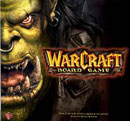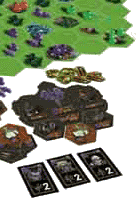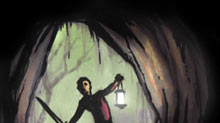by Mike Sugarbaker
 WarCraft: The Board Game
WarCraft: The Board Game
Published by Fantasy Flight
Designed by Kevin Wilson
13 board pieces,
40 wooden melee unit markers,
28 wooden ranged unit markers,
16 wooden flying unit markers,
4 town interfaces,
8 outpost markers,
32 building tiles,
32 worker markers,
36 unit tiles,
84 spell cards,
50 gold tokens,
50 wood tokens,
18 depletion tokens,
4 battle dice,
1 resource die,
14 quest tokens,
color rules booklet
2-4 players
$39.95
Ladies and gentlemen, WarCraft has left the computer,
and this time it's survived. Many have tried and many have died
- Alternity StarCraft Adventure Game, anyone? - but this
is the first tabletop-gaming conversion of Blizzard's real-time
strategy juggernaut that comes close to capturing what makes it
great. Dazzling cutscenes notwithstanding, the WarCraft
franchise has never really been about story. It's about gameplay,
and moreover, it's about gameplay between real live human intelligences,
not single-player AI. We here at the Cave have yet to look closely
at the latest WarCraft RPG, this time from Sword & Sorcery,
and it certainly looks more credible and satisfying that any of
Wizards of the Coast's old Blizzard-licensed properties... but it's
still not exactly setting the world on fire, is it? Roleplaying
is simply not the mode of gameplay that can do justice to the soul
of RTS. It was clearly going to take a board game... but the board
game had to be done right. Fantasy Flight has done a bang-up job.
I played a four-player game on the default four-player board layout,
as the humans. My partner, opposite me on the board, was a moderately
experienced player of WarCraft II and III, playing
the night elves faction. Our opponents were the orcs and undead,
the orcs being played by an inveterate WarCrafter who tended to
mutter "zug zug" every time he built a worker, and other such color
commentary. I wish I could say I myself never moaned "job's done" in a vaguely butler-ish voice when I constructed buildings,
but, well, I'm a geek.
Where Eagle's Age of Mythology conversion focused on all the little complex details of resource building, putting the whole game there, FFG's WarCraft makes the crucial change of putting the board back in. Units are stripped down to three basic types, not the byzantine cast of thousands of AoM, but the tradeoff is there's actual positional play in this game, and it matters where your units are. It matters even more, at least in the default scenario, to secure the resources you need to build and survive: wood and gold. They're right there on the board, and can be battled over and protected. AoM's sole source of this kind of thing was what you drew when it was time to draw a field, Puerto Rico-style. FFG's solution feels much closer to the salient properties of RTS gameplay - resources and combat and game objectives are tied together on the board. You must build workers, who fan out to gather resources (under the protection of your units), so you can pay for buildings, so you can build more units, so you can protect more resource-gathering sites, so you can make more cash, upgrade your units, and make them kick more ass.
 Your units and workers (they aren't the same thing; knowing that from the beginning can prevent a lot of rules confusion) start in your Town, which is represented by one space on the board. Your town is, of course, also represented by a big old control panel that you keep off the board. It comes with two buildings on it at the start of the game, one for making workers and one for making melee units. You can only build buildings in town if you have a worker on your town space; he gets devoted to the off-board task until it's done, which is always in two turns for practical purposes. (The Deploy phase comes right before the Buy phase, so your town workers get freed up from construction just in time to start again.) You can only ever build as many units at one time as you have buildings to build them with, so keeping workers at home to increase your capacity is just as important as keeping workers in the field to chop wood and mine gold (and keeping units out there to protect them).
Your units and workers (they aren't the same thing; knowing that from the beginning can prevent a lot of rules confusion) start in your Town, which is represented by one space on the board. Your town is, of course, also represented by a big old control panel that you keep off the board. It comes with two buildings on it at the start of the game, one for making workers and one for making melee units. You can only build buildings in town if you have a worker on your town space; he gets devoted to the off-board task until it's done, which is always in two turns for practical purposes. (The Deploy phase comes right before the Buy phase, so your town workers get freed up from construction just in time to start again.) You can only ever build as many units at one time as you have buildings to build them with, so keeping workers at home to increase your capacity is just as important as keeping workers in the field to chop wood and mine gold (and keeping units out there to protect them).
WarCraft's combat is much simpler and more satisfying than AoM's, and I'd wager (heh) that it has less luck in it. But the better comparison is to something less straight-ahead exception-based, and more positional. The two lovely things about combat in WarCraft are the rhythm of it - first ranged units, then air units, then melee (which can't kill air units) - and the flanks. You only fight when you enter a space with enemy units in it with one of your units, but all the units in the spaces surrounding the contested space participate in the fight. The battle is over the contested space, though, and only ends when only one side's units remain there. When casualties are inflicted, you yourself choose who dies on your side, so you have a chance to make decisions about whether to stay in or not by choosing your dead from the flanks or from the main event. However, striking 'em down in the flanks might affect other battles. Very elegant. Probably not unprecedented in combat games on a Risk-y kind of level, but whatever.
Our orcish friend, the online RTS veteran, says that this board game has
one large point in common with WarCraft III: the night elves are
insanely overpowered. This may be true - in the little pile of chits that
represents the progressions through "levels" of each of your three types
of units, the night elves reach amazing proficiency with quick-acting
ranged units in a very short time. The differences between the factions
mostly lie in these upgrade stacks, one for each type of unit. The humans
can only get each of their unit types up to level 3, whereas orcs can get
crazy with melee and elves own ranged. (The other differences between
factions lie in special abilities units sometimes get at high levels, as
well as the spell card deck, which I'll get to next.) But I think Mr. Orc
can share some
of the blame for rushing blindly into the situation instead of building up his position further. Overall, the balance between the factions seems okay, although a tweak to the night elves might not be unwelcome - we'll have to play more to be sure.
Each faction has a separate deck of spell cards, which you draw one of every time you enter a combat. The cards have some standard special tricks you can pull, such as boosting the movement of all units on a given space, or hopping a bunch of people back to your HQ to stop it burning to the ground. They also have a menu of special combat actions that are different for each race. There's no reference card, and passing the rulebook around to read up on what we could do was a little irritating. (Why aren't the rules on the cards? There's room.) But, while they add complexity to an admirably simple game, we had a great time with them because... well... they add complexity to a simple game. They also add flavor - undead can do undeaddy things with them, night elves can do tree-hugging hippie crap with them, et cetera.
Anyone who's been following my tastes and experiments in board gaming over the past couple of years knows I have a predilection for what I just call "Risk-likes" - games that are simpler than full-on wargames, simple enough for comparatively casual gamers, but have depth and meat to them nonetheless. WarCraft is one of my favorites since I started the search. I'm already looking forward to trying other scenarios, getting regular games together, and working this one a lot deeper than most of the games I own. Basically, if you're looking for stuff to chew on, it's unquestionably here, but the focus is on fun, and that's what gets delivered.
| Similar reviews on OgreCave: |
|
|




